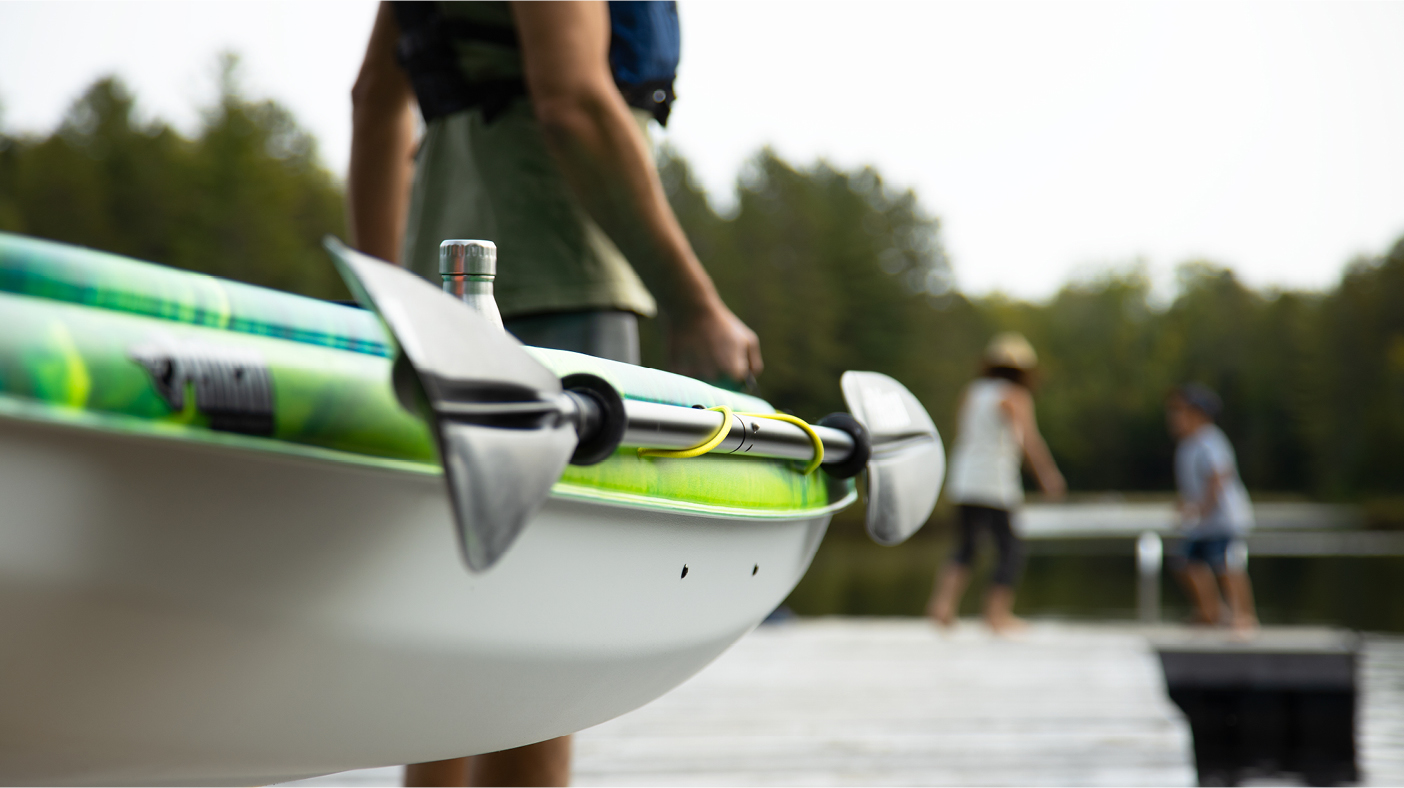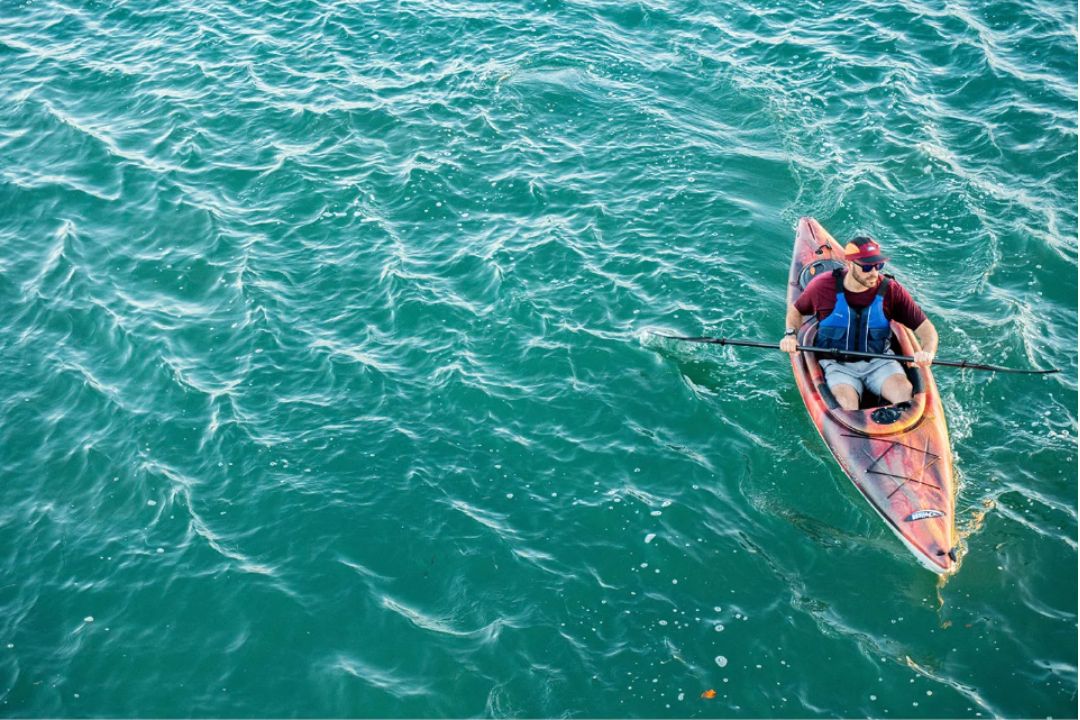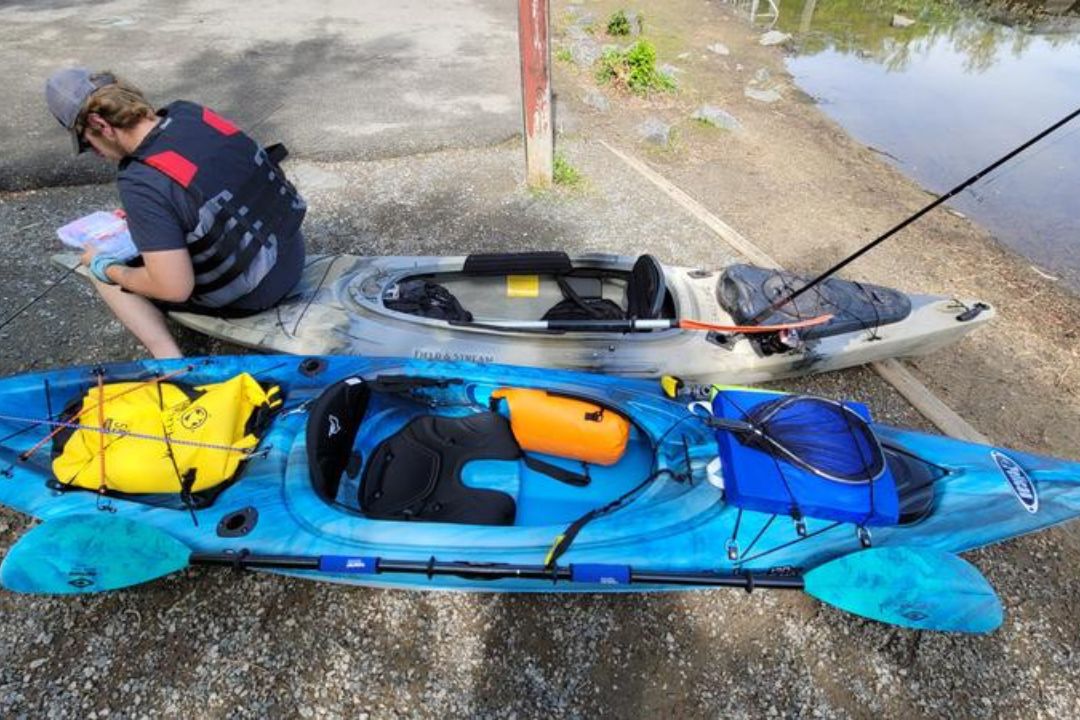3 Great Backpacks for Your Trip
Outdoor Activities | August 1, 2025
SAIL
May 19, 2025

Did you know you can choose from a wide range of kayaks to paddle the waters of Quebec and Ontario, from sea and river kayaks to one- and two-person kayaks, sit-on-top and sit-inside kayaks to rigid and inflatable kayaks? The resident watersports specialist at SAIL, provides an informative overview of the key categories of kayaks and essential factors to consider when selecting your own.
In this article, you will discover how to choose the best kayak for your adventures on the water:
What is the ideal kayak for your nautical adventures? That depends! Here are some questions to ask yourself so you can make the best choice.
Recreational kayaks are particularly suited for calm bodies of water, such as lakes or rivers with slow currents. For more turbulent waters, choose a sit-inside kayak that is highly manoeuvrable and can maintain its course through waves and eddies.
The longer the kayak, the easier it is to keep it stable and stay on course. A longer shape also allows the kayak to glide easily through the water, maximizing the reach of each paddle stroke. On the other hand, the shorter the kayak, the easier it is to change directions and keep your balance.
When deciding on the right measurements for your future kayak, you should also think about its capacity. Ask yourself who is going to use it, if you prefer to paddle solo or in pairs… Consider your means of transportation as well; will you put your kayak on a roof rack, inside your vehicle, or in the trunk of a Communauto?
A recreational kayak will be perfect if you plan to go on day outings or short camping trips. For more active excursions, look for whitewater kayaks and sit-inside models. If you enjoy fishing, you may also want to consider a fishing kayak, which is perfectly suited for this activity.

Sit-on-top kayaks are perfect for paddling on calm bodies of water. They can be inflatable or made of rigid plastic. Unlike sit-inside kayaks, where you’re seated partly below the water’s surface, sit-on-top kayaks offer a relatively high seating position. Because this position above the water is less stable, sit-on-top kayaks are wider to ensure optimal flotation. They also provide more room for movement, especially for the legs.
Who’s it for? Paddlers looking for stability over performance.
A sit-on-top recreational kayak is ideal for beginner kayakers and those who want to spend a few hours on calm bodies of water.
One-person sit-on-top kayaks are between eight and 13 feet long (2.4 to 4 metres), whereas tandem models are between 13 and 15 feet long (4 to 4.6 metres). Recreational kayaks offer excellent stability, and most models come with adjustable seats and moulded footrests for different leg lengths. Recreational kayaks also have several bungee cords attached to the hull to secure your gear.
Most recreational kayaks are rigid, but there are also inflatable models. They are made from durable rubber and filled with air, so they tend to bounce slightly on the water. Nevertheless, they are still quite stable and can quickly be folded away, making them easy to store and carry. Inflatable kayaks are also very light, weighing around 40 pounds (or 18 kilograms). Additionally, they take less than 10 minutes to inflate and deflate with a foot pump.
Who’s it for? Recreational kayaks are available in both one- and two-person models. They’re an appealing choice for families who want to introduce their children to the joys of water activities. Incidentally, if this is your case, you should know that some brands, like Pelican, also make smaller-sized kayaks for kids.
Are you an avid angler seeking a quiet and peaceful way to reel in your next catch? A recreational fishing kayak could be the thing you’re looking for.
Most fishing kayaks have sit-on-top designs that allow you to move freely. They usually have hulls that glide silently through the water and provide optimal stability and a comfortable platform for stand-up fishing. Additionally, fishing kayaks come equipped with multiple rod holders and plenty of storage space for a fish finder, tackle box, water bottle and other equipment.
Some brands even make fishing kayaks with foot pedals – take Pelican’s The Catch 130 Hydryve, for example. These kayaks allow you to move around on the water, as in a pedal boat, and still have your hands free for fishing.
Who’s it for? Experienced anglers.

Sit-inside kayaks are suitable for recreational use on calm waters and for sporting purposes on rivers and oceans. They always have a rigid design, tapered plastic hull and low seat that’s close to the surface of the water. This makes them very stable and easy to manoeuvre. They respond keenly to the paddler’s strokes and body movements. The closed cockpit protects the paddler’s legs from elements, like the rain, waves, wind and sun. Interior compartments allow for transport of equipment.
Who’s it for? For paddlers looking for performance over stability.
If you want to spend several hours on calm or slightly agitated waters, your best bet is a recreational sit-inside recreational kayak, such as the Pelican Mustang 120X or Rise 100X, or the Argo 136XP if you’re looking for a tandem model. Sometimes referred to as touring kayaks, recreational kayaks are incredibly versatile. They are sturdy and made of rigid plastic, and they sometimes have a rudder to make steering left and right a breeze.
Who’s it for? Intermediate and advanced kayakers.
If you’re an experienced kayaker who wants to spend several days on large lakes and rivers or at sea, you need a sea kayak.
Sea kayaks always have a rigid, sit-inside design. They are also frequently equipped with a rudder or centreboard to maximize manoeuvrability, and have several watertight compartments to carry camping gear and the necessities for a day on the water. They range in length from 13 to 18 feet (4 to 5.5 metres).
It is a good idea to use a nylon or neoprene skirt to prevent water from entering the kayak when going over large waves.
Who’s it for? Experienced kayakers.
River kayaks are suitable for whitewater rafting (from R1 – easy for beginners – to R5 – obstacles, falls, strong current for experts only). They are solid, small (between 6 and 8 feet long) and have a curved hull that looks like a duckbill. They are extremely manoeuvrable but require strong whitewater navigation skills and in-depth knowledge of rescue techniques like the Eskimo roll. River kayaking is a relatively dangerous sport and should never be done alone.
Who’s it for? Experienced and expert kayakers only.
The right clothing:
Focus on water-resistant or quick-drying materials to ensure optimal comfort and protection from the elements. Remember to bring a change of clothes and extra layers: a rain jacket, UV-protective clothing, a warm sweater… Keep them dry with a good, watertight dry bag, which can also safely hold your keys, cell phone, camera or any other precious item.
A kayak paddle:
Choose a paddle specifically adapted to your use. Some models are versatile and suitable for all kinds of recreational activities – like Pelican’s Symbiosa paddle, which has the added benefit of being adjustable to fit several kayak measurements (and kayakers’ sizes). There are also paddles designed specifically for fishing. For example, the Poseidon Angler from Pelican includes a hook retrieval system built into the blade and a measuring tape along the shaft to measure your catch of the day.
A life jacket:
Always have a life jacket or personal flotation device (PFD) with you for safety and to reduce the risk of drowning. Find the right model for you with our article on the best types of PFD for every nautical activity.
A cooler:
This is a must-have accessory to ensure your food and drinks stay cold, especially in hot weather. If you are fishing, a cooler is also the best way to keep your bait and catch cool.
A map or GPS:
It’s always a good idea to bring along some sort of navigation tool, especially if you’re going on a long expedition or paddling large bodies of water. Remember to pack a map in your dry bag whenever you venture into unfamiliar areas. For even greater accuracy, consider a GPS, which will always get you to your destination.